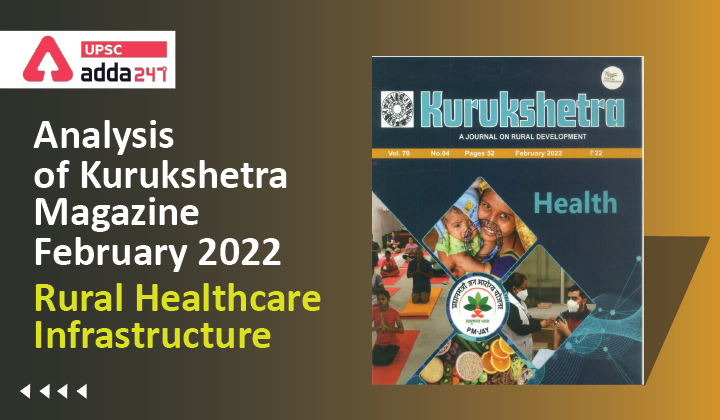Table of Contents
Analysis of Kurukshetra Magazine: Rural Healthcare Infrastructure
Relevance
GS 2: Health, Government Policies & Interventions, Issues Relating to Development
Introduction
- With more than 70 per cent of India’s population living in rural areas, the importance of rural healthcare facilities cannot be overemphasised.
- The healthcare facilities in rural areas under the National Rural Health Mission (as part of the National Health Mission) have been developed as a three-tier system – Sub-Centres, Primary Health Centres (PHC) and Community Health Centres (CHC).

- As per Rural Health Statistics, 2019-20, there are 155404 Rural Sub-Centres including 18610 Ayushman Bharat Health & Wellness Centres – Sub Centres (AB-HWC-SCs), 24918 nos. of Rural Primary Health Centres (PHCs) including 16635 AB-HWC-PHCs and 5183 nos. of Community Health Centres (CHCs).
- Under Ayushman Bharat, the existing Sub-health Centres (SHCs) and Primary Health Centres (PHCs) are being transformed into AB-HWCs to deliver twelve packages of Comprehensive Primary Health Care (CPHC) that includes preventive, promotive, curative, palliative and rehabilitative services which is universal, free and close to the community.
Coordinative Approach Between Centre & State
- Public Health & Hospital is a State subject, the responsibility of strengthening public healthcare system, especially in rural areas including setting up of new hospitals, dissemination of information regarding COVID-19, up-gradation and strengthening of existing health facilities lies with the respective State/ UT Governments.
- The proposals from State/UT Governments are received in the form of Programme Implementation Plans (PIPs) under National Health Mission (NHM) and the Government of India provides approval for the proposals in the form of Record of Proceedings (RoPs) as per available resources.
- Under National Health Mission, States/UTs in their programme implementation plans have been given the flexibility to propose for filling of gaps measured against IPHS including that of services.
- This is then appraised by the National Programme Coordination Committee and as per its recommendations, approved by the Ministry of Health and Family Welfare (MoHFW).
How NHM proved a game-changer?
- In the 15 years of implementation, the National Health Mission has enabled the achievement of the Millennium Development Goals (MDGs) for health.
- It has also led to significant improvements in maternal, new-born, and child health indicators, particularly for maternal mortality ratio, infant and under-five mortality rates, wherein the rates of decline in Indio are much higher than the
global overages and these declines have accelerated during the period of implementation of NHM.
NHM and India’s Immunization Program
- World‟s largest vaccination drive, National COVID-19 Vaccination Programme (NCVP) utilizes the infrastructure and logistic arrangements created under Universal Immunization Programme (UIP).
- The entire immunization programme relies on the platforms created by NHM.
- Also, the training of healthcare providers across the spectrum for effective COVID-19 management utilizes the NHM Training framework.
How is PM Ayushman Bharat Mission helping in developing RHI?
- PM Ayushman Bharat Health Infrastructure Mission (PM-ABHIM) increased investments in public health and other health reforms to provide better access to health in rural areas by:
- Strengthening of Health and Wellness Centres in villages and cities for early detection of diseases.
- Addition of new critical care-related beds at district-level hospitals.
- Support for Block Public Health Units (BPHU) in 11 high focus states.
- Integrated district public health laboratories in all districts.
- National Ambulance Service under NHM for free transportation to health facilities is extended to remote and rural tribal areas also.
- States are encouraged to adopt flexible norms for engaging specialists at public health facilities.
- Another essential component of Ayushman Bharat Health & Wellness Centres (AB- HWCs) is the rollout of teleconsultation services through e-Sanjeevani.
What is e-Sanjeevani?
This platform provides telemedicine services for the communities through a hub and spoke model which connects AB-HWCs(spokes)to District Hospitals/Medical colleges(Hubs)for specialist consultation.
The Crucial Link in the Rural Healthcare System
- One of the key components of the National Rural Health Mission is to provide every village in the country with a trained female community health activist – ASHA (Accredited Social Health Activist).
- The ASHA worker acts as the interface between the community and the public health system in rural India.
- The ASHA benefit package provides coverage for:
-
- Pradhan Mantri Jeevan Jyoti Beema Yojana (PMJJBY)
- Pradhan Mantri Suraksha Beema Yojana (PMSBY)
- Pradhan Mantri Shram Yogi Maan-dhan (PM-SYM)



 TSPSC Group 1 Question Paper 2024, Downl...
TSPSC Group 1 Question Paper 2024, Downl...
 TSPSC Group 1 Answer key 2024 Out, Downl...
TSPSC Group 1 Answer key 2024 Out, Downl...
 UPSC Prelims 2024 Question Paper, Downlo...
UPSC Prelims 2024 Question Paper, Downlo...





